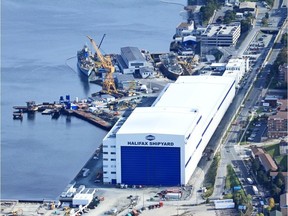It spent a mere five years in service before alleged vandals cut iron cables holding it in place, causing it slip out into the icy Atlantic
Published Jan 05, 2025 • Last updated 6 minutes ago • 4 minute read

A Canadian Coast Guard vessel that cost about $21.6 million to build will soon be scrapped at a cost of $412,000.
Those numbers are big but are just a few of the many numbers involved in building and maintaining a fleet of heavy duty marine security vessels.
1 of nine new Coast Guard ships
The CCGS Corporal McLaren M.M.V. is the sixth vessel of the Coast Guard’s nine Hero-Class patrol vessels that were launched between 2012-2014.
Advertisement 2
THIS CONTENT IS RESERVED FOR SUBSCRIBERS
Enjoy the latest local, national and international news.
- Exclusive articles by Conrad Black, Barbara Kay and others. Plus, special edition NP Platformed and First Reading newsletters and virtual events.
- Unlimited online access to National Post and 15 news sites with one account.
- National Post ePaper, an electronic replica of the print edition to view on any device, share and comment on.
- Daily puzzles including the New York Times Crossword.
- Support local journalism.
SUBSCRIBE FOR MORE ARTICLES
Enjoy the latest local, national and international news.
- Exclusive articles by Conrad Black, Barbara Kay and others. Plus, special edition NP Platformed and First Reading newsletters and virtual events.
- Unlimited online access to National Post and 15 news sites with one account.
- National Post ePaper, an electronic replica of the print edition to view on any device, share and comment on.
- Daily puzzles including the New York Times Crossword.
- Support local journalism.
REGISTER / SIGN IN TO UNLOCK MORE ARTICLES
Create an account or sign in to continue with your reading experience.
- Access articles from across Canada with one account.
- Share your thoughts and join the conversation in the comments.
- Enjoy additional articles per month.
- Get email updates from your favourite authors.
THIS ARTICLE IS FREE TO READ REGISTER TO UNLOCK.
Create an account or sign in to continue with your reading experience.
- Access articles from across Canada with one account
- Share your thoughts and join the conversation in the comments
- Enjoy additional articles per month
- Get email updates from your favourite authors
Article content
Ottawa’s original plan for this fleet was to have 12 constructed. However, Canadian government planners hit a familiar stumbling block known to other nations while making big-ticket purchases: the shipbuilders wanted more money for the ships than the government was prepared to pay.
Eventually, 12 became nine and the nine vessels were built in the Irving Shipyards in Halifax as part of a $194-million contract.
Irving was awarded the contract in 2009. The company delivered the first ship in 2012. The last of the nine launched in 2014.
The 43-metre-long Corporal McLaren M.M.V. was launched in October 2013.
At the beginning of the construction contract, the shipyard estimated the build would employ up to 155 people over four years. That meant a lot to the greater Halifax community as it would inject means an added $35 million into the local payroll.
Irving also estimated that about 50 local Nova Scotian suppliers would benefit from about $32 million in purchases of local goods and services — in addition to 130 suppliers throughout the rest of Canada.
Former Nova Scotia premier Darrell Dexter said at the time that the province would be providing Irving Shipbuilding a $12.2 million performance guarantee through its Industrial Expansion Fund.
By signing up you consent to receive the above newsletter from Postmedia Network Inc.
Article content
Advertisement 3
Article content

2 main coasts patrolled by the ships
The new mid-shore patrol vessels replaced existing vessels nearing the end of their life expectancies.
Painted in a distinctive red and white pattern that these vessels have become known for, they are “iconic symbol(s) of maritime safety and the sovereignty (in) Canadian waters.”
Five of the vessels have been used to enforce maritime security, supporting the federal Department of Fisheries and Oceans conservation and protection programs in the Maritimes, Quebec and Pacific Regions. That means guarding against foreign fishing vessels entering Canada’s internationally recognized 200-mile limit, as well as ensuring federal fishing regulations are followed, and when necessary, seizing and recovering illegal fishing gear.
The Corporal McLaren M.M.V. was in this group.
The other four vessels were conscripted to a joint program with the Royal Canadian Mounted Police to enhance the maritime security along the Great Lakes – St. Lawrence Seaway system.
3 key design numbers
Construction of each vessel was based on Damen Stan’s Patrol 4207 design, the patrol vessel measures 42.8 metres long overall with a beam of 7 metres. The ship is constructed of steel and aluminum and has a 253 gross tonnage.
Advertisement 4
Article content
Each ship has a fuel capacity of 7,500 imperial gallons giving the vessel a range of 2,000 nautical miles (3,700 km) at 14 knots (26 km/h) and an endurance of 14 days.
Each carries a complement of nine with five officers and four crew and has five additional berths.
This fleet of ships was plagued by flaws in the early going.
Before construction even began, the project team identified concerns about water flowing from compartment to compartment, putting the ships at higher risk of sinking, along with rolling stabilization issues and concerns with the ability to lower lifeboats with crew aboard. Those problems were not mitigated during the vessels’ design and construction, union officials said at the time.

4 big costs of the ship’s demise
Jumping ahead to May 2016, the CCGS Corporal McLaren M.M.V was taken out of service due to corrosion of steel plates in the ship’s stern (the back end).
While it underwent repairs, the ship was docked at the Bedford Institute of Oceanography research station in Dartmout, where it was vandalized in 2018.
Halifax Police said their preliminary investigation revealed someone damaged the ship, cutting the iron cables that kept it in its moorings, which caused the ship to slide into the ocean. Since this would not be a sabotage job for amateurs, the police treated the incident as suspicious.
Advertisement 5
Article content
However, the mystery of the sabotage was never solved and the police never caught the perpetrators.
The Coast Guard cut ties with Canadian Maritime Engineering (CME), the Dartmouth, N.S. shipyard that had been performing the repair work when it was vandalized.
Though, the National Post revealed last year that Ottawa awarded a half-million-dollar drydock contract to the Pictou Shipyard owned by CME, the same company that owned the site where the vessel was damaged in the first place.
In a lawsuit against CME, the coast guard claimed the vandals’ efforts resulted in $14 million worth of damage. While it was partially submerged, several compartments in the vessel filled with icy seawater, resulting in damage to computer equipment and rendering the wiring useless.
Initially, Ottawa set a budget of $11 million for the vessel’s repairs. But even though the damaged ship was refloated, a tender was eventually issued in June of 2024 for scrapping the damaged vessel.
Last fall, the coast guard awarded a $412,000 contract to Marine Recycling Corporation to break down and recycle the ship after it was deemed “surplus.”
5 years in operation
The Corporal McLaren M.M.V spent a mere five years in service before its demise at the hands of vandals. $21.6 million is a big price tag for a short lifespan.
Our website is the place for the latest breaking news, exclusive scoops, longreads and provocative commentary. Please bookmark nationalpost.com and sign up for our daily newsletter, Posted, here.
Article content

 5 days ago
1
5 days ago
1












.png)



















 Bengali (BD) ·
Bengali (BD) ·  English (US) ·
English (US) ·